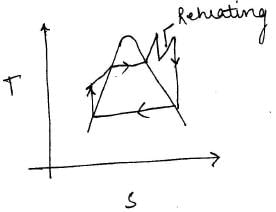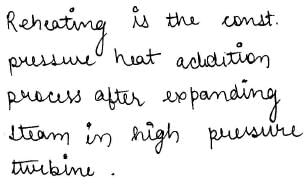Mechanical Engineering Exam > Mechanical Engineering Questions > Reheating of steam under ideal condition take...
Start Learning for Free
Reheating of steam under ideal condition takes place at constant
- a)entropy
- b)enthalpy
- c)pressure
- d)temperature
Correct answer is option 'C'. Can you explain this answer?
Verified Answer
Reheating of steam under ideal condition takes place at constanta)entr...


Most Upvoted Answer
Reheating of steam under ideal condition takes place at constanta)entr...
Reheating of Steam under ideal conditions takes place at constant pressure. This means that during the process of reheating, the pressure of the steam remains constant. Let's understand this in detail.
Constant Pressure Process:
A constant pressure process is a thermodynamic process in which the pressure of the system remains constant. During the process, work is done by the system, and the heat energy is supplied to the system. In this process, the volume of the system may change.
Reheating of Steam:
Reheating of steam is the process of heating up the steam after it has passed through the high-pressure turbine. The steam is expanded in the turbine, and its temperature drops. The steam is then reheated to increase its temperature and then passed through the low-pressure turbine. This process improves the efficiency of the power plant.
Ideal Conditions:
Under ideal conditions, the process of reheating of steam is assumed to be reversible, adiabatic, and isentropic. In this process, there are no losses due to friction or heat transfer. The process is assumed to be ideal and perfect.
Constant Pressure in Reheating of Steam:
During the process of reheating, the pressure of the steam remains constant. This is because the steam is heated up in a reheater at constant pressure before it enters the low-pressure turbine. The reheater is designed to maintain the pressure of the steam. If the pressure of the steam changes during the reheating process, it can affect the efficiency of the power plant.
Conclusion:
In conclusion, the reheating of steam under ideal conditions takes place at constant pressure. This is because the reheater is designed to maintain the pressure of the steam during the process of reheating. This process improves the efficiency of the power plant.
Constant Pressure Process:
A constant pressure process is a thermodynamic process in which the pressure of the system remains constant. During the process, work is done by the system, and the heat energy is supplied to the system. In this process, the volume of the system may change.
Reheating of Steam:
Reheating of steam is the process of heating up the steam after it has passed through the high-pressure turbine. The steam is expanded in the turbine, and its temperature drops. The steam is then reheated to increase its temperature and then passed through the low-pressure turbine. This process improves the efficiency of the power plant.
Ideal Conditions:
Under ideal conditions, the process of reheating of steam is assumed to be reversible, adiabatic, and isentropic. In this process, there are no losses due to friction or heat transfer. The process is assumed to be ideal and perfect.
Constant Pressure in Reheating of Steam:
During the process of reheating, the pressure of the steam remains constant. This is because the steam is heated up in a reheater at constant pressure before it enters the low-pressure turbine. The reheater is designed to maintain the pressure of the steam. If the pressure of the steam changes during the reheating process, it can affect the efficiency of the power plant.
Conclusion:
In conclusion, the reheating of steam under ideal conditions takes place at constant pressure. This is because the reheater is designed to maintain the pressure of the steam during the process of reheating. This process improves the efficiency of the power plant.

|
Explore Courses for Mechanical Engineering exam
|

|
Similar Mechanical Engineering Doubts
Reheating of steam under ideal condition takes place at constanta)entropyb)enthalpyc)pressured)temperatureCorrect answer is option 'C'. Can you explain this answer?
Question Description
Reheating of steam under ideal condition takes place at constanta)entropyb)enthalpyc)pressured)temperatureCorrect answer is option 'C'. Can you explain this answer? for Mechanical Engineering 2025 is part of Mechanical Engineering preparation. The Question and answers have been prepared according to the Mechanical Engineering exam syllabus. Information about Reheating of steam under ideal condition takes place at constanta)entropyb)enthalpyc)pressured)temperatureCorrect answer is option 'C'. Can you explain this answer? covers all topics & solutions for Mechanical Engineering 2025 Exam. Find important definitions, questions, meanings, examples, exercises and tests below for Reheating of steam under ideal condition takes place at constanta)entropyb)enthalpyc)pressured)temperatureCorrect answer is option 'C'. Can you explain this answer?.
Reheating of steam under ideal condition takes place at constanta)entropyb)enthalpyc)pressured)temperatureCorrect answer is option 'C'. Can you explain this answer? for Mechanical Engineering 2025 is part of Mechanical Engineering preparation. The Question and answers have been prepared according to the Mechanical Engineering exam syllabus. Information about Reheating of steam under ideal condition takes place at constanta)entropyb)enthalpyc)pressured)temperatureCorrect answer is option 'C'. Can you explain this answer? covers all topics & solutions for Mechanical Engineering 2025 Exam. Find important definitions, questions, meanings, examples, exercises and tests below for Reheating of steam under ideal condition takes place at constanta)entropyb)enthalpyc)pressured)temperatureCorrect answer is option 'C'. Can you explain this answer?.
Solutions for Reheating of steam under ideal condition takes place at constanta)entropyb)enthalpyc)pressured)temperatureCorrect answer is option 'C'. Can you explain this answer? in English & in Hindi are available as part of our courses for Mechanical Engineering.
Download more important topics, notes, lectures and mock test series for Mechanical Engineering Exam by signing up for free.
Here you can find the meaning of Reheating of steam under ideal condition takes place at constanta)entropyb)enthalpyc)pressured)temperatureCorrect answer is option 'C'. Can you explain this answer? defined & explained in the simplest way possible. Besides giving the explanation of
Reheating of steam under ideal condition takes place at constanta)entropyb)enthalpyc)pressured)temperatureCorrect answer is option 'C'. Can you explain this answer?, a detailed solution for Reheating of steam under ideal condition takes place at constanta)entropyb)enthalpyc)pressured)temperatureCorrect answer is option 'C'. Can you explain this answer? has been provided alongside types of Reheating of steam under ideal condition takes place at constanta)entropyb)enthalpyc)pressured)temperatureCorrect answer is option 'C'. Can you explain this answer? theory, EduRev gives you an
ample number of questions to practice Reheating of steam under ideal condition takes place at constanta)entropyb)enthalpyc)pressured)temperatureCorrect answer is option 'C'. Can you explain this answer? tests, examples and also practice Mechanical Engineering tests.

|
Explore Courses for Mechanical Engineering exam
|

|
Signup for Free!
Signup to see your scores go up within 7 days! Learn & Practice with 1000+ FREE Notes, Videos & Tests.
























